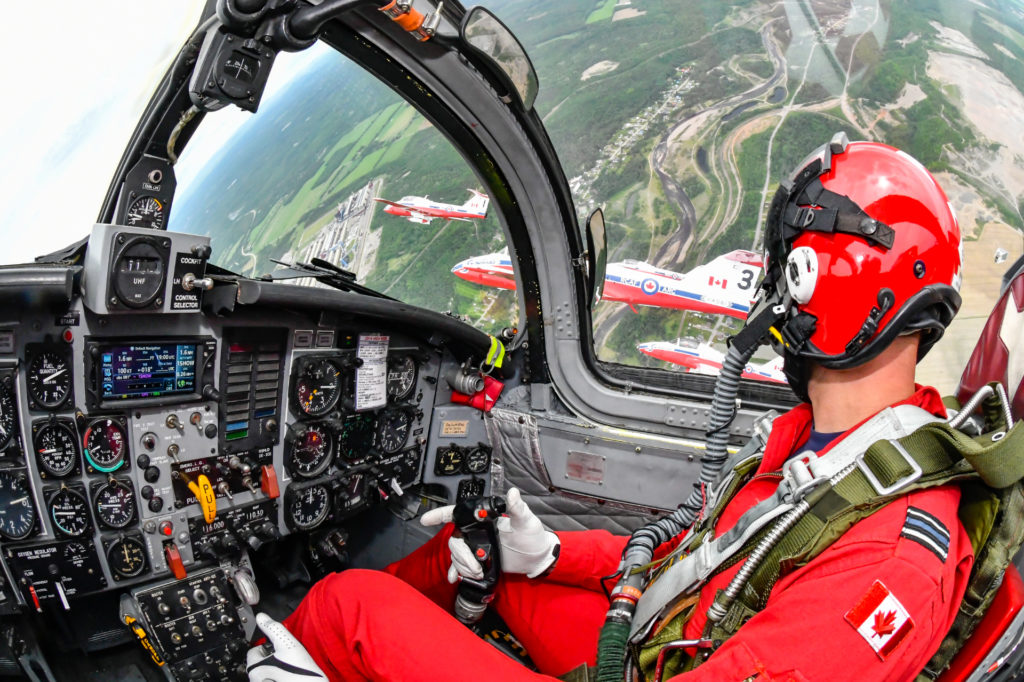Estimated reading time 3 minutes, 59 seconds.
The Royal Canadian Air Force (RCAF) fleet of CT-114 Tutors is back in the air, following a “thorough technical and operational risk analysis” in the wake of two serious accidents within an eight-month period.

On Aug. 24, the commander of 2 Canadian Air Division, BGen Denis O’Reilly, lifted an operational pause that had been in effect since a fatal May 17 crash in Kamloops, B.C. That accident claimed the life of Capt Jennifer Casey, public affairs officer for the Canadian Forces Snowbirds.
Casey was riding in the team’s No. 11 jet alongside pilot Capt Richard MacDougall, who sustained serious but non life-threatening injuries.
The Snowbirds team was in B.C. as part of Operation Inspiration, their cross-country tour saluting Canadians’ efforts to combat the coronavirus pandemic.
The CT-114 Tutor – first acquired by the RCAF in 1963 – is operated by the Snowbirds at 15 Wing Moose Jaw, Sask., and the Aerospace Engineering Test Establishment at 4 Wing Cold Lake, Alta. The RCAF’s primary jet trainer until 2000, a total of 23 Tutors remain in the fleet.
In addition to the May 17 accident, another CT-114 crashed near Atlanta, Ga., on Oct. 13, 2019. The pilot, Capt Kevin Domon-Grenier, received minor injuries. He successfully ejected from the aircraft after experiencing a loss of thrust, but later reported “anomalies” with the ejection sequence and parachute opening. The aircraft was destroyed upon impact.
The subsequent investigation by the military’s Directorate of Flight Safety (DFS) zeroed in on a fuel delivery system failure within the Tutor’s engine, probably at the engine oil cooler fuel inlet port.
Investigators also determined that the “mostly likely cause of the parachute malfunction was the result of one or more parachute pack retaining cones having been released prior to the activation of the MK10B Automatic Opening Device.” Suspension lines became entangled with parts of the ejection seat, impacting proper parachute deployment.
Following the report, the RCAF inspected all related Tutor Aviation Life Support Equipment to ensure airworthiness. The DFS also recommended CT-114 engine inspections and changes to associated procedures, in order to identify damaged oil coolers that may be at risk of leaking.
A preliminary report for the fatal Kamloops accident was issued on June 1. It indicated that those investigators are focusing on environmental factors (a possible bird strike) and the performance of the aircraft emergency egress system. While operations are now resuming, the Tutor fleet will be subject to a series of risk mitigation measures, including some restrictions on flying operations and a focus on increased maintenance.
Experts continue to evaluate the May accident; when their analysis is complete, the RCAF will determine whether any additional measures are required to ensure safe operations.
Back to Moose Jaw
The Snowbirds’ CT-114 Tutors, grounded in Kamloops since May 17, will return to the team’s home base at 15 Wing Moose Jaw over the next two weeks.
The remainder of the team’s 2020 season – along with Operation Inspiration – have been officially cancelled.









Well the report tells me and any reasonably thinking individual that DFS does not know what caused the Kamloops failure. Presumption of a bird strike with no forensic evidence. Just a blurry photo. There was a death and critical injuries here. That concerns me. Is there a number of failures and or deaths that DND has in mind before they retire the CT-114 Tutors? Or is it the number of years in service .. 60.. 70 … 75 years regardless of failures and deaths. Which is it? Taxpayers and the RCAF pilots have a right to know. RAF pilots trained and flew Sopwith Camels in WW1 but the RAF weren’t using them as their front line demonstration team aircraft in the 1970’s were they? NO.